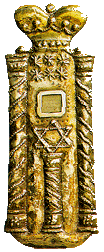World
Religions & Cultures
|
The Mezuzah, with the star of David, Israil's
greatest king
|
Different
Approaches:
The Mezuzah is a tiny parchment scroll inscribed
with biblical exts and enclosed in a case. Traditionally, Mezuzahs
are fixed to the door-frames of Jewish homes. They usually contain
the words of the Shema from the Bible, which calls God's people to love
him totally. (Langley 43) |
God and His Laws
For all Jews, God is both utterly transcendent,
"wholly other," yet near to His creation, in particular His creature, Man.
God is a moral being, as the paradigm of ethical
conduct: a holy, just, and merciful being.
The people are the instrument of God, His chosen
vessel to bear witness to Him for all humans. The covenant is the
alliance or pact between God and his people. It is the alliance to which
He will be utterly faithful, no matter how faithless the people might be.
The idea of covenant starts with Adam, goes through Noah, but "The Covenant"
is the promise God made to Abraham, who becomes the first Patriarch of
the Jewish religion (a role he plays in Christianity and Islam as well).
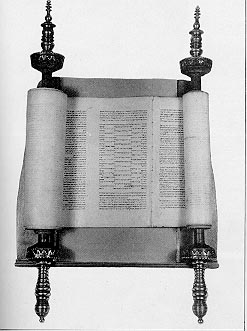 |
Torah, "instruction" or "revelation," is the way of imitating God and
becoming holy like Him. The Torah (using the article) is the Holy
Book of Judaism and is comprised of first five books of the Old Testament
(Genesis, Exodus, Leviticus, Numbers and Deuteronomy). They are also
called The Pentateuch.
Left: A scroll containing the Torah, the 'Five
Books' supposedly written by Moses. The Jews are traditionally known
as the people of the Book . The Jewish Museum, New York.
(Parrinder
393)
|
The Talmud are the authoritative interpretations
of the texts of the Bible and interpretation of oral traditions.
Kosher (kashrut) is a set of dietary laws
governing Orthodox Jews. Forbidden foods include pork, shellfish and scavengers,
the separation of meat and dairy products, and the manner in which food
is prepared.
The sabbath or holy day for Jews starts
at sundown Friday and runs till sundown Saturday. Jews will sometimes go
to temple for services led by the rabbi, or spend time with family.
Orthodox Jews are forbidden to work on this day and take this rule seriously
-- no cleaning, school work, cooking (foods are prepared the day before),
travel. It's a time for God and family.
|
 At prayer in the synagogue. This man wears
phylacteries bound to head and arm, containing portions of the scriptures,
and a tallit or prayer shawl. (Parrinder
415)
At prayer in the synagogue. This man wears
phylacteries bound to head and arm, containing portions of the scriptures,
and a tallit or prayer shawl. (Parrinder
415) |
Special
Holy Days
| Passover (Pesach)
is an eight-day celebration commemorating the flight from slavery in Egypt.
The story is told in the Book of Exodus. There are special foods
eaten and the special dinners are called seders. Since the date is based
on a lunar calendar it's not fixed, but it usually occurs in early April.
Left: A Jewish family gathered together
for the seder or Passover feast. On the table can be seen the unleavened
bread which commemorates the hasty way in which the Israelites left Egypt.(Parrinder
406) |
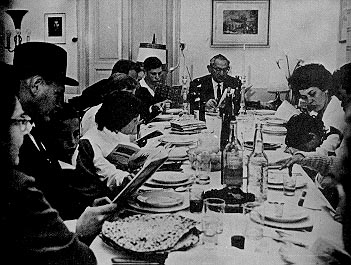 |
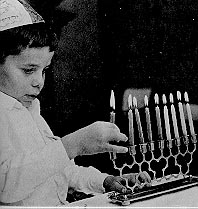 Lighting the last candle of chanukkah.
The eight branches of the candlestick commemorate the eight days for which
a miraculous supply of oil lasted during the re-dedication of the temple
of Jerusalem in 165 BC. (Parrinder
415)
Lighting the last candle of chanukkah.
The eight branches of the candlestick commemorate the eight days for which
a miraculous supply of oil lasted during the re-dedication of the temple
of Jerusalem in 165 BC. (Parrinder
415) |
Chanuka (also Hanukka or
The Festival of Lights) celebrates a military victory and the miracle
of the temple lights burning for eight days when there was only enough
oil for one. Jews light the menorah, an eight-branched candelabrum, have
special dinners, give small gifts, play games and sing songs. This usually
falls sometime in December and because of that is sometime called "Jewish
Christmas," but that's a totally misleading misnomer. |
Rosh Hashana is the Jewish New Year.
It usually falls in mid- to late September and is a time of joy and feasting.
Yom Kippur (The Day of Atonement) This
is the holiest of holy days for Jews. It occurs two weeks after the
New Year, and it's a day of fasting, mourning and prayer for forgiveness
of sins. It's a somber and serious day, but also one of joy, since God
is merciful and forgives sins.
Different
Approaches
Orthodox
Orthodox Jews usually prefer the term Traditional
Judaism. They adhere to the traditional way of Torah, regarding both
scriptural and traditional expression of Torah as binding, shaping daily
life according to its teaching. This group keeps kosher, separates men
and women during worship, and prays exclusively in Hebrew. The dress of
women is also highly regulated (collarbones, elbows, and knees covered,
and for married women, their hair as well) and men as well have special
ritual clothes that should be worn.
Conservative
A more moderate approach which emerged during the
19th century, this form stresses the need to be as faithful
as possible to the way of Torah. It continually reassesses its particular
directives in the light of present-day needs, adapting the traditional
teachings in order to make prophetic Judaism come to life in a unique way.
Reformed
This form also emerged in the 19th century.
It broke with tradition in its attitude toward the binding authenticity
of Biblical and Talmudic interpretations of Torah, stressing, instead,
the ethical dimensions of Judaic faith. Since this group does not regard
Jewish law as divine in origin, it sees no need to follow them. Non-morality
based laws are ignored. They also allow women full equality in religious
matters.
Hassidim
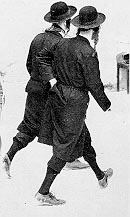
A sect of ultra-orthodox mystical Jews
which originated in Eastern Europe in the 18th century and have
since settled in large numbers in Brooklyn, NY, but they are in other places
as well. Their way of life and style of dress has changed little since
the 19th century. They are often portrayed in movies as something
"different," and are easily seen when visiting New York City as many work
in the diamond market, though they work in many fields as well.
Photo: Hasidic Jews in Jerusalem.(Parrinder
416) |
A panel of rabbis study the marriage contract
at a unique Hasidic wedding in New York. The bride came from
a line of miracle-working rabbis. (Parrinder
416)
|
Secular
This is a more modern usage. People use this term
to culturally ally themselves with Judaism, but to say that they don't
have any religious ties to Judaism.
Picture source:
1. Parrinder,
Geoffrey, ed. World Religions: From Ancient History to the Present.
New York: Facts on File, 1971.
2. Langley, Myrtle.
Religion (Eyewitness Guides.) New York: Dorling Kindersley,
1996.
